Part VI: Settlements and Settlers
Chapter 15: The Struggle to Survive
During the year-and-a-half of America’s involvement in World War I, the Syrian-Lebanese shared an experience that was far different from any they had encountered in their own land. Centuries of domination by the Ottoman Turks had suppressed for most any stirring of nationalism they might have felt. Conscription into the Turkish army was not for the purpose of defending their own country but to preserve the strength and power of the Turks and their Empire. Why should they do this? Better get to America as fast as possible. Here it was different. Here they could belong to this country, and this country to them as soon as they could get their citizenship papers.
Numbers of Cleveland Syrians went into the army while still aliens with a committment that they would then get their citizenship. They had something to fight for. Too, a new sense of pride was rising among them as news filtered over that the Arabs in the Middle East were blowing up all the railroads from Medina to Jerusalem, thus breaking Turkish communications and turning the tides of war in favor of the Allies in that theater. Colonel Lawrence,[1] Prince Feisal and the leaders of a dozen tribes were becoming as well known as General Allenby, General Pershing, and Woodrow Wilson. The Syrian-Lebanese now had their heroes on both sides of the water.
Everyone followed the war news avidly. The Lusitania was a name that evoked grief and anger. “Lady Liberty” was a symbol of patriotism and pride. The Kaiser and the Boche were the enemy. Turkey was the arch enemy and the news of each victory over her was received with joy. The heroism of the desert chieftains restored a lost dignity. For the Cleveland Arabs, World War I was a uniquely personal war. Their men were fighting in the American Army, and their compatriots of the old countries were playing a vital role in the Allied victories.
During the War, the flu epidemic took its toll in the Cleveland community, and the pain was compounded by the knowledge that relatives back home in the old country were suffering not only from influenza but famine as well.
Families went to each other’s aid and took turns nursing the sick.
Henry George, whose orchestra and Cabin Club were for many years a highlight of the Cleveland entertainment circuit recalls the flu epidemic on Bolivar Road.
“Our house was like a field hospital. My mother, Admah George, had cots set up in double rows, along the length of each room, and I remember the smell of medicine, ointments and disinfectants, mixing with the steam from boiling kettles on the stove. The flu was highly contagious, but she had enough faith to insist she wouldn’t get sick because so many people needed her. She just kept going, sleeping in her clothing and moving from cot to cot, checking the patients through the night. I guess she was right, for she didn’t get sick, she just didn’t have the time.”
It was a year of Liberty Bonds, high prices, and shortages of foods that were sent to the Front instead. Coffee and sugar, two necessities in the Arab household were sorely missed.
No one blamed Woodrow Wilson, who was the hero of the hour, and many a grandmother drinking tea, or a mixture of chicory, would add his name in her prayers as she asked a blessing for the sick in America, the hungry in the old country, and the good “Malek” (King) Wilson who had everyone to worry about.
When church bells and factory whistles hailed the Armistice of November 11, 1918, the Arabs in Cleveland rushed out and joined the happy frenzy in the streets. Birth records for that year show a few Woodrows recorded. Two other names broke a record for popularity, joining the ranks of the Somia’s, Alexanders, Abraham’s and Mariam’s permanently. “Victor” and “Victoria,” were now an integral part of the Arab-American nomenclature.
Horrifying stories of the war’s aftermath began to reach Cleveland from the Lebanon and other parts of the Middle East. Starvation had struck all the familiar villages, hamlets and hills, and thousands had died. Each letter set off days of mourning. The names of the beloved relatives, dead or sickened, were upon the lips of every daughter and sister, brother and son throughout the Arab homes of Cleveland. With the horror and shock came a renewed determination to bring to this land of health and safety the survivors of the dead brothers and sisters, and families set themselves to this task with vigor.
The following years, until the Quota Act of 1924 put an end to the hopes of thousands, more thousands of Syrians and Lebanese came into the United States. Hundreds reached Cleveland and were reunited with relatives from whom they had been long separated.
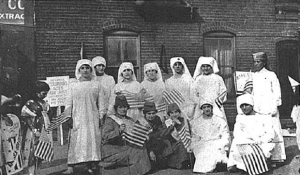
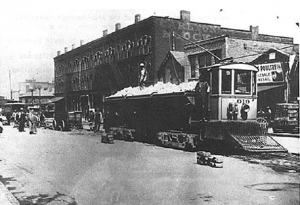
The boom of the 1920’s not only touched the lives of the Syrians and Lebanese, among them some of the newest of immigrants, but uplifted them upon a wave of prosperity that took them to new heights. They invested in real estate, and some, like their American counterparts, plunged into the stock market. The old “kashi” peddler pack, sewer and street work job of the early years gave way to the wholesale house, construction company, garage and automobile shop, fine restaurant or import business.
Some of the younger men attended business colleges and studied management and accounting so that the family businesses could be operated in a more efficient manner. Sometimes one would be heard to mutter, “I’m working on the adding machine, and the old man is still running it up in his head and on his fingers, and dammit he always comes out right, and beats me to it.”
The doors of medical or law schools were opening to more young men, and young women were insisting on their rights to go on to college. Some broke down parental resistance, and eventually family attitudes changed from doubt to pride in the daughters’ accomplishments.
Other young women went into business, setting up dress shops and import stores, or found jobs as secretaries. The liberation of Arab-American women was now keeping pace with that of their American sisters.
One young woman, age 20, took Fred Kohler, one of Cleveland’s toughest Mayors, to court over a piece of rental property. She won her case, kept her property and set about developing it into a good investment. Her name was Julia Macron and she won success even though, like most of her generation, her education never reached high school level.
The Arab-Americans of the Roaring Twenties were beginning to intermarry with other nationalities and fast assimilating into the mainstream of American life.
The Wall Street crash and the great Depression which followed affected many of the small businesses which had begun so optimistically. For some, the gains made in the years of plenty were wiped out in a matter of hours. Students quit school and took jobs; families joined forces to regain their losses, and Cleveland’s Arab-Americans like everyone else in America tightened their belts and added more water to the “shawraba.” Around the big kitchen table they would spend their evenings listening to Jake and Lena, while they strung manufacturers’ tags or assembled small parts in piece work jobs at home.
The Depression notwithstanding, they continued in their goals of assimilation. They organized cultural and political groups, aided in the Americanization of their more recently arrived friends and relatives, and joined civic groups which were not totally ethnic in their composition. The 1930’s was a decade of growth and social development for the Arab-American community in Cleveland. The long struggle to overcome language barriers, cultural differences, and social and political discrimination was beginning to bear fruit.
Bolivar Road had faded into nostalgic memory as families followed the patterns of urban migration and moved further and further away from the central city to both east and west suburbs. Acculturation and the efforts toward assimilation brought the Arab Americans into ever closer proximity to the broad community. Like immigrant families of other nationalities, their life styles and customs did not completely merge into that of the Anglo-Saxon mainstream but rather, flowed parallel in a comfortable side by side channel of watchful acceptance.
Politicians of both the Democratic and Republican parties, always on the lockout for re-enforcements, went among the Arab-American leadership and offered greater political involvement in the government of the Republic, an exciting prospect and challenge which brought promises of employment and prestige.
Some of the Arab-Americans who were approached lacked formal education. Some, on the other hand, were better educated than many of the native Americans in the wards where they attended meetings. All, however, shared a common goal — an insatiable desire to make it good in America, and a pioneer spirit to achieve that ambition. Moreover, they were not yet a generation disenchanted with the American dream. For them the flag, the national anthem, the Pledge of Allegiance were the staff and watchword of the convert’s zeal, and they flung themselves with the energy and enthusiasm of the missionary to bring their landsmen into the privileged American activity of political involvement.
Among such leaders was a man whose love affair with America began during World War I when he served with the American Red Cross in Zahle, Lebanon. His mother was of mixed parentage. Her name was Louise Hurley. She was the child of a German father who was a political refugee from the Austro-Hungarian Empire, and of a Syrian mother. Jamil Kaim was the second youngest of six children born to Louise and Shaheen Kaim in 1892. Jamil’s birthplace was the town of Aiteneet, in the fertile Bekaa Valley of Lebanon.
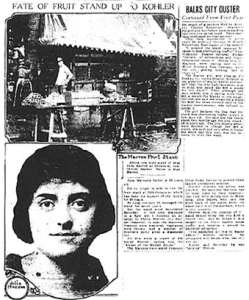
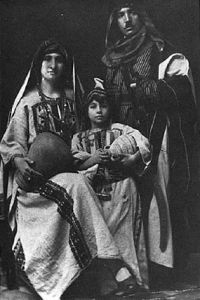
Shaheen and Louise Kaim sent the boy to primary school in Aiteneet. Ambitious for the best education they could provide for him, they then enrolled him in the American High School in Shweir, and from there he entered the American University of Beirut.
Prior to World War I, he had worked for the Sudan Railway, and from 1918 to 1920, served with the American Red Cross in the reconstruction and rehabilitation of the Lebanon.
Jamil Kaim, pursuing the love for America which had begun in his native land long before, came to the United States in 1920. Upon his arrival in Cleveland, he went into business and then threw himself into the activities of the Arab American community.
He was elected president of St. Elias’ Church Council in 1922 and held that office periodically over a span of more than forty years.
He was a joiner, organizer, and innovator, and in 1930 he gathered a number of his countrymen together to form one of the first Syrian Lebanese Democratic Clubs in the United States.
With a salutation of “Dear Compatriot” a letter was circulated to the entire Syrian Lebanese community inviting them to meet on a Sunday in September at 1400 East 55th Street to join the efforts of the Aiteneet Brotherhood Association to “secure recognition from the Democratic Family.”
Since the Aiteneet Brotherhood which he had organized the year before had been able to get some results within a year, reasoned the foresighted Jamil, it would be advantageous to unite as many of his “compatriots” as possible in the entire Arabic community in a common goal.
“Let us stand firm with our mutual thoughts for a better world, and better conditions for our people,” wrote Jamil Kaim. “Let us work together so that our ultimate goals and ambitions will be a shining example for all others to follow.”
The Aiteneet Brotherhood which was sometimes known as the Aiteneet Syrian American Democratic Club listed its first officers as James (Jamil) Kaim, James Abood, Ernest Sabath, Mufleh Nahra, George Bird (Asfour), Tom Abood, Nasif Shibley, George Rahal, Aziz Thomey, and Mabas Nahas.
The Lebanon Syrian Democratic Club, which was organized following the letter to “Dear Compatriot,” was active for many years and Jamil Kaim led it through several terms in office. Some of its other officers were James Abood, Dave Caraboolad, Elias Caraboolad, and Mary Amor Savolis, a high spirited individualist who was credited with many firsts among Cleveland Arab-American woman. Her marriage to a Greek was one of the earliest of the “mixed marriages.” From the Twenties on, she had demanded equality of participation for women, and spear headed war drives, fund raising projects and relief efforts. Her leadership during the Lebanese Earthquake of 1956 was particularly memorable and her activities in numerous civic organizations set the tone for later generations to follow.
Jamil Kaim did not trust a single language to communicate his messages. Campaign letters supporting candidates for public office always included an Arabic translation, and the favored candidate’s name was always spelled out clearly in English in the middle of an Arabic sentence. Jamil, who was fast becoming “Uncle Jimmy” to the younger generations, was meticulous and careful that everyone should get the message exactly right.
Jamil Kaim firmly believed in reaching as many of his compatriots as was possible, and in informing the broader American community about his people. For this, radio was the answer, and in 1930, he organized and directed the first Lebanese Radio Program, its goal to preserve the cultural heritage of the Syrian-Lebonese people.
He had hundreds of friends throughout the city, in the business and political community particularly. He was a walking employment agency, his office in his pocket, names and telephone numbers on dozens of notes, as he found jobs for the many people who depended on him for help. Politics was a second nature to him and he continued in his work of founding Lebanese Syrian Democratic Clubs in Toledo, Akron and Canton. Appointed chairman of these various groups for the State of Ohio by President Franklin D. Roosevelt, Jamil Kaim plunged into his political and patriotic activities with the happy innocence of a boy on his first job, and the nationalistic fervor of an American zealot.
World War II found him at the head of a Syrian-Lebanese “Help Win the War” effort. Representatives of all the Arabic speaking organizations in Cleveland were mobilized into a committee which raised funds for a fully equipped mobile canteen which they donated to the Red Cross. They continued to pledge donations for war relief for the next three years until the end of hostilities.
“When the American Flag and our Motherland Flag is called to our attention,” Jamil Kaim once wrote, “the blood through my veins sparkles with inspiration, since patriotism and brotherly love towards our countrymen are my incentives. Since my youth I believed in them and have preached them to all my countrymen.”
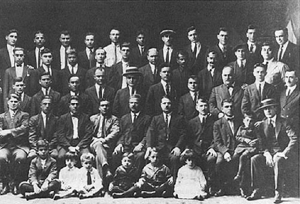
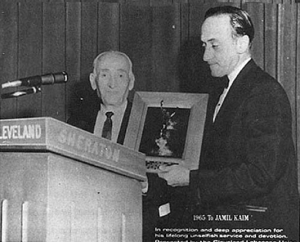
These were the years of intense loyalties to those men who had a family history of leadership, or who had taken strong command in the earliest years of immigration. Some led by force of a charismatic and dynamic nature. Issues were not as important as personalities or the one-to-one relationship, a characteristic uniquely Semitic.
Men like Jamil Kaim organized groups and held them together by the power of their own persuasive temperaments. They were men who were admired and respected because they had accomplished something, had gained success in business or politics in spite of the language and social barriers. They had broken through into the Masons, the Knights of Columbus and the Democratic and Republican parties. They owned businesses or had respectable professions and had won recognition not only from their own people but from the broad community as well.
These were the men who came forward as leaders in the twenties and thirties and continued on to become the elders in the forty to fifty years following. They were the men, and the women too, whose funerals were solemnized by the presence of five, six, or seven priests and bishops in the sanctuary, and whose funeral corteges, a block long, often took a detour from the usual route to take the deceased for one last drive past the place of business he had built up over the years out of the first dollars saved and unbelievable physical endurance. It was only in retrospect that later generations came to realize the capabilities and worth of these, the truly brave ones — the pioneers who had paved the road that others would follow.
During the Thirties, civic and cultural involvement became more intensified, and the Arabic speaking Americans joined in community theater, debate clubs, and nationalities’ festivals. They participated in the planning of the Cleveland Cultural Gardens, joined unions and civic associations.
The International Institute, forerunner of today’s Nationalities Services Center, was instrumental in assisting two young women’s groups to organize. These were the Syrian Junior League and the Capricornians, their younger sisters.
The name of the Junior League evolved after weeks of debate and soul searching for a suitable title. Some opted for Zenobia, in honor of Syria’s warrior queen, and some thought Subaiyah would do well. However, Zenobia smacked of too much attachment to ancient Syria, and did not seem right for an American group, and Subaiyah could not be adequately translated, since the word lay somewhere along the meaning of “young ladies,” “jeune Filles” or “marriageable virgins.”
The name “Syrian Junior League” was changed in the mid 40’s. The Cleveland Junior League, an earlier organization was concerned that two Junior Leagues might cause some confusion in the community. Since Lebanon had declared its independence in 1943, the opportunity was ripe to include the name of that state, and the Syrian Junior League became the Lebanese-Syrian Junior Women’s League.
From its beginning, the Syrian Junior League, under the guidance and gentle “nagging” of Miss Margaret Fergusson, executive secretary at the International Institute, plunged into educational and welfare projects, activities which remain the major function of the organization today, now in its fiftieth year.
Christmas and Easter dances, outings on the Goodtime and the Aquarama, plays, card parties, bazaars, annual country club dinner dances, were all planned for the purpose of raising funds for children’s institutions overseas, scholarships for Cleveland students of Syrian-Lebanese descent, and donations to welfare agencies in Cleveland.
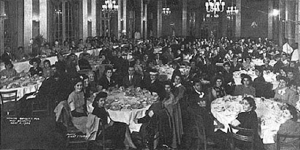
When the campaign for a mobile canteen was launched during World War II the Syrian Junior League was one of the most enthusiastic and successful of the groups collecting donations.
In its early years the association with the International Institute gave the organization a stability that enabled it to establish a sturdy base and broadened scope, bringing its members into close relationship with other nationality groups also headquartered at the Institute.
The annual “Hanging of the Greens” was an evening of Christmas festivity in which conviviality, nationalism, a happy competitive spirit, music, dancing and good food were mixed together in happy human companionship. The winding stairways and mahogany bannisters, fireplaces and mantles, sparkling leaded windows, and crystal and brass chandeliers of the old mansion that housed the Institute, were ornamented with green boughs, scarlet velvet, and Christmas tokens of many nationalities.
As Linda George Anter, a charter member of the League says: “We had everything there. There were German cookies, and Swedish straw ornaments, and all kinds of nationality things. Pictures, dolls, bells on the trees, candles and lights everywhere. We all shared Christmas together. We talked about our different customs, sang nationality songs, danced our dances. They were beautiful times and we made many friends; even when we moved away from the Institute many of us remembered the help that Margaret Fergusson gave us. We learned there and we grew.”
Other charter and early members of the League were: Somia George Abookire, Linda Abraham, Martha Abraham, Linda Amor Asher, Sophie Zlaket Augustine, Anne Shibley Bird, Ann Zlaket Ganim, Elizabeth Jacobs Ganim, Emily Joseph Ganim, Sally Abraham George, Adelle Aftoora Hamra, Elizabeth George Hatton, Louise Hatton, Josephine Charley Kassouf, Carolyn Kaim Koury, Mathilda Thomas Mady, Victoria Shalala Otto, Nellie Sabath, Marie Assef Samia, Edna Smith Shalala, Ida and Josephine Shalala, Edna Beshara Zarzour, and Nora Ganim Zarzour.
Many of the founders and early members continue to direct their energies toward the welfare of the present day organization.
As the group expanded and its membership increased it became necessary to move club activities from the International Institute to the Sheraton Cleveland Hotel. When the Sheraton was closed for renovation in 1977, the Women’s League took temporary quarters in the Plaza Hotel.
The Capricornian Club which had been organized for younger sisters did not continue long, since those members joined the League itself as soon as age permitted, and newer generations became involved in coed teen clubs at their own churches.
The Arab Arts in Cleveland
On January 12, 1930, two stories appeared in the Cleveland Plain Dealer which recorded a highlight in the history of the Syrian-Lebanese in Cleveland.
The first on page nine was headed, “Syrian Actors Tonight Open in P.D.’s ‘Theater of Nations.'”
Something different in the theater is in store for Clevelanders tonight. For the first time anywhere the dramatic aspirations of different national groups have been focused in a single, central small theater for a cycle of plays and ambitious musical productions.
The theatricals of these groups are being transplanted from obscure halls in widely scattered parts of the city to the setting of a model play house. The Little Theater of Public Hall, completed two years ago with the idea that it would be a workshop of the theater for Cleveland’s community players. The Plain Dealer Theater of the Nations tonight presents its opening production, “The Robbers,” Schiller’s dramatic narrative, the work of Cleveland Syrians under the auspices of the Syrian American Club.
The play has been given before by the Syrian players, coached by Chick Shantiry and Dr. H. B. Khuri, who have given creditable presentations of Shakesperean plays and Syrian classics as well.
It is given in Arabic, native tongue of the Syrian people. Each group in the Plain Dealer Theater of the Nations will keep to its own language in following through the drama series, for which more than a score of productions are now scheduled ahead . . . “The Robbers,” and the presentation to follow will be staged under the direction of K. Elmo Lowe, assistant director and Max Eisenstat, technical director, who are bringing to the production the best developments of their work at the Play House.
But against the background of scenic and lighting effects provided by Eisenstat and Lowe, the play itself will be the native theater of the Syrians. Every encouragement has been given to bring this atmosphere into the fine setting of the Little Theater . . . the story of the play is the romantic one of the disinherited son of the old noble. Count von Maxmillian, and his robber band in the forest of Bohemia. The love interest is there in the attachment of Amelia von Edelreich, niece of the Count, for the dashing robber chieftain and the jealousy of the other son, Francis.
The brigands rob in the Robin Hood fashion, cutting the purses of the rich to help the needy, until the count dies and their leader wants to go back to the title and estates. Amelia and the Robber are united in tragic death when he refuses to abandon his band.
Julius C. Dubin is director of the Theater of the Nations. Associated with him are Beatrice F. Kalish and Hannah B. Goodman.
The story was accompanied by a sketch of the actors in 19th century European clothing.
On page 10 of the same issue, William F. McDermott, the drama critic wrote:
I think the nature of this initial drama is sufficient justification for one of the prime ideas motivating the entire project, which was that this succession of plays would give Clevelanders in general a new understanding of the richness and vigor of the culture of the different alien groups which reside in our midst and of which most of us know so little.
I must confess that in that choice (Schiller’s play), I learned more about contemporary Syria and Syrians than I had found out in my previous lifetime. Schiller is a great German poet, second only to Goethe, and “The Robbers” is one of the world’s great masterpieces of dramatic literature . . . In fifteen years or so of writing about the theater I have never been called upon to review this drama in an American play house. I think it strange and worthy of remark that the first opportunity I have had to do so should be offered by a group of Cleveland Syrians. The play will be given of course, not in German, but in Arabic. It is a round about way of introducing a German classic and it suggests a number of things about present day Syria and the Syrians, one of which is that their dramatic taste is more cultivated than that of Broadway and America.
What play do you suppose a group of Americans residing in a foreign country would select to present in their own language before a people speaking another language? Would they choose something by Shakespeare, or Ibsen, or Hauptman, or maybe one of the Theater Guild’s more ambitious products? I believe it very likely they would select “Abie’s Irish Rose.”
Nothing could be more serious than “The Robbers.” It is as tragic as King Lear, and full of turbulent action, of a frenzy of feeling, and the majesty of the sombre.
In choosing this play from the dramatic literature of the world as the first offering in this series . . . can we assume that there is something in it akin to the genius of the Syrians, something that they especially understand and find sympathetic, and perhaps to the average American theatergoer that assumption will explain a great deal about a country which he knows vaguely as one of the oldest in the world and which he would have difficulty in definitely locating on the map.
The following day, January 13, 1930, William McDermott’s critique appeared on page one of the Cleveland Plain Dealer. It was headlined: “Fire and Passion Mark First Play in Theater of Nations,” and a sub-heading stated that the theater was filled.
Mr. McDermott said:
The Theater of the Nations, a civic project long dreamed of by local people interested in the drama and in the cultural life of the many foreign groups resident in Cleveland, was brought to its first fruition under the sponsorship of the Plain Dealer last evening in the Little Theater of Public Hall with the presentation by Cleveland Syrians of Schiller’s poetical drama, “The Robbers.” The first performance on this program which was under the auspices of the Syrian American Club justified the planning and the hoping that had gone into it . . . Here was a masterpiece of the romantic German drama, done in Arabic, and done with a fluency and force that showed evidence not only of unusual special aptitude but of long training in the acting and producing of such dramas. It was an amateur presentation and pretended to nothing more, but it was not the sort of amateur production to which we are used in the English speaking theater.
Not only was there no hesitation, no laggardness in catching up cues or none of the contretemps that usually typifies a production by amateurs, but there was in the playing of the principle parts, a quite unusual feeling for melodramatic character and an ability to project that feeling over the stage to an audience many of whom were not acquainted with the language in which the actors spoke.
McDermott speaks of the “storm and stress” of the play, the robustness and violence of the characters. “To play such characters satisfactorily requires a certain vigor, a broadness and sweep of method, something like that needed for the playing of Shakespeare . . . and this Syrian company so far as I can judge, knowing no Arabic, brings to it just that quality.”
The drama is full of long soliloquies, of speeches so tenuously drawn out that the memories of the actors must be at considerable pains to retain them.
Realistically spoken, they would certainly tire an American audience pretty intolerably. These actors speak them as they are intended to be spoken, with heat and emphasis, thereby infesting what is essentially untheatrical with a certain color and liveliness . . . Daher Rumya enacts the hero, Charles von Moor, a character in the creation
of which Schiller was obviously influenced by Hamlet, just as there are traces of Richard III and Iago in another principal character, Francis, the villainous brother . . . George Ziady as Francis is especially notable for the force and fluency of his personation of this extraordinary villain, and Daher Rumya as Charles gets the feeling of the brooding Hamlet quality of this character coupled with a fiery resoluteness which was not at all Hamlet-like but quite in keeping with Schiller’s hero. Sadie Shantiry brings an effective voice and a skillful technique to the role of the heroine, and Chick Shantiry adequately evokes the weakness and pathos inherent in the character of the father of the two warring sons. Count von Moor.
There were a number of vivid and forceful characterizations among the robber band, and the whole performance was distinguished by a continuous liveliness and an unusual definiteness in the delineation of character.
The following year, the presentation of the Syrian players for the Theater of the Nations was a five act historical drama by Chickry Ganim. Antar Ben Shaddad, which was first presented at the Theater de l’Odeon in Paris in 1910. A Plain Dealer story on February 26th, 1931, declared it had been unanimously acclaimed by critics for its rapid dramatic action, colorful atmosphere and epic grandeur.
It was announced that the play would offer “special scenic effects, native Syrian music, and the famous traditional sword dance . . . to make this offering one of the most vivid in the Plain Dealer series. Oriental dances would be performed by Mary Shantiry, Amelia Haddad and Gazaleh Courey.
On February 27, 1931, the following article appeared in the Plain Dealer:
“Syrian Play is Tale of Warrior”
Antar Ben Shaddad, Syrian Dramatic Club’s presentation in the Plain Dealer international drama series at Public Hall’s Little Theater Sunday afternoon faithfully follows the historical tradition of its hero.
Antar, sometimes called the Bedouin Achilles, is no imaginary person, but a celebrated warrior of the seventh century and author of one of seven poems suspended in the Kaaba at Mecca.
Feats of prowess, the beauty of song, undying love, great and simple nobility of soul, all characteristics dear to his people, make him their greatest hero.
The romance of Antar, and not, as generally supposed, the Thousand and One Nights, is the work which is the source of stories told in the tents and coffee houses of Syria, Egypt and Arabia.
In those far off lands there is a class of professional story tellers, most of whom are blind, who tell only these tales. Such a man is called an Antari.
Antar was the son of Shaddad, by a black woman whom his father had made captive in a predatory excursion. By the heroic qualities which he displayed from his earliest youth, the hero raised himself from the state of slavery in which he was born, to the confidence of the king, a pre-eminence above all the chiefs, and to marriage with the beautiful Princess Abla.
The roles in the drama are played by:
Joseph Shiekh as Antar; John Sadich as Shiboob, his half brother; Sam Kassouf as Malik, Prince of the Beniabs; Sophie Jeha as Princess Abla, his daughter; Mrs. Dorothy Joseph as Selma her waiting maid; Karim Khury as Prince Amarat, Antar’s rival; George Ziady as Zobier, captive chief of an enemy tribe; Elias Kaforey as a prince; Fred Shaheen, Assad Abraham and Elias M. Ellis as shepherds.
Dramatic performances continued for several years, even after the Theater of Nations project was concluded. Members of today’s “elder” generation often talk about the exciting moment when the house lights dimmed and the curtain went up on magnificent scenes of Damascus gardens or the opulent splendor of an Arab palace. For many who were children then, memories are evoked of a beautiful mother in her thirties, standing center stage, resplendent in satin and jewels, pouring out the rich notes of an Italian or French opera in Arabic; or of a father, noble and brave, a desert chieftain, sword raised high, dedicated to saving the city and his people from the enemy.
Sports
In March of 1937, a newspaper story headlined: “A Woman in a Man’s World — Edna” disclosed one of the first of the women’s liberation breakthroughs in sports competitions.
“The Men Resent it but Net Queen Plays in Their Tourney,” was the subheading of the story which began: “I think the men resent it,” laughed Edna Smith (whose name was a translation of the Arabic “Haddad”), the tennis star who is now performing in her and Cleveland’s very first co-ed tennis tournament. Edna was asked how men react to a tennis beating from a woman. Nasty rumors abound that the boys objected to letting Edna into the city men’s singles tournament at the Indoor Tennis Center. The dark-haired midget sized (four feet, eleven) city and state champ is the only gal entered.
And on Monday night the worst fears of the male tennisers were realized. Edna swamped Colin Richards by 6-0, 6-2 in the first round. Sunday afternoon she returns to the wars against Bob Tryon of the John Carroll netters.
“Putting me in the men’s tournament was the idea of Phil Greenstein, manager of the Indoor Center,” revealed the possible spear head of a new woman’s suffrage movement in the field of sports.
“But the co-ed idea never will spread,” maintains Cleveland’s best woman tennis player.
“The reason it seems is that the U.S. Lawn Tennis association elders would be aghast at the very suggestion and would never, never sponsor a mixed tournament, anymore than the University of Illinois will allow co-eds on the college golf team.”
The story suggested that Edna Smith’s main intention in getting into the men’s tournament was to improve the standard of women’s tennis in Cleveland.
Edna Smith, went on collecting trophies in city, state and national competitions. One of the first Arab American graduates of Ohio State University, she began a twenty year teaching career in the early 1930’s in the Cleveland Catholic Diocese, and in Sisters College, the forerunner of St. John’s College. She married James Shalala in 1939 and when their twin daughters were in school she herself returned to the classroom, switching careers to earn a law degree. Edna Smith Shalala became the first woman attorney of Syrian-Lebanese descent to practice law in Cleveland.
Education
By the mid thirties, American colleges were experiencing an academic invasion that would set the stage for broad changes in the educational systems of institutions of higher learning.
The children and grandchildren of the immigrants of the early 1900’s, graduating from high school in the years of the Depression, realized that a high school diploma was no longer adequate if they were to establish a firm footing in the professional and economic mainstream of American life.
With the sons and daughters of native Americans, the ambitious Syrian-Lebanese waited table in college cafeterias, did housework and baby sitting in faculty homes and worked at any odd job that would help them earn that coveted sheepskin.
Cleveland Arab-Americans went to Ohio State, Western Reserve and neighboring universities. Getting their Bachelor’s degrees, a few continued the struggle into medical and law schools and other specialized fields.
While the ambitions and determination of all of these students was noteworthy, there was one Cleveland student whose struggle for higher education was an epic of perseverance, self sacrifice, and victory over a physical handicap that in the thirties carried a stigma that was not limited to the group but was universal.
Born in St. Louis, Raymond Shibley was blinded, as numbers of children were at the time because of improper eye care at birth. When the family moved to Cleveland, Nasif Shibley, his father, opened a grocery store, staunch in the belief that a self-owned business would afford independence and security for the family. He feared for the future of his son and was determined that the boy would not have to rely on the kinds of jobs open to the blind for his livelihood.
“My father had an obsession about it,” says his daughter, Anne Shibley Bird. “He was in his forties when he died, and through his last illness he pleaded with my mother and myself to keep Raymond in school and see that he got as much education as possible. He would say, ‘Don’t ever let your brother have to carry a tin cup, or sell pencils on the street. You must promise that this will never happen.'”
Toward this goal for higher education, Nellie Shibley, the mother and her daughter Anne, threw all their resources. The grocery store was open for long hours, seven days a week and the energies of mother and daughter were spent in making it successful in order to finance the son’s education.
On graduation from East High School, Raymond applied to Western Reserve University but was rejected on the grounds that he would be unable to keep up with his classes because of his handicap.
Mother and daughter, fortified by friends and well wishers in the entire community, bombarded the admissions office with pleas, demands, and letters of support until finally the exception was made and the young man enrolled.
In June of 1937, Raymond Shibley was graduated from Adelbert College of Western Reserve with a Bachelor’s degree in liberal arts with a major in French. He graduated cum laude in a class of approximately one hundred and fifty.
This was not yet enough. While his sister remained at home to run the family business, Raymond Shibley and his mother travelled to Lebanon, to the family village of Aiteneet. There he was married to Latifie Abu-Nader, and the young couple set sail for Paris and the Sorbonne.
Of a class of seventy in French phonetics, thirty-five failed the courses. Raymond Shibley, in spite of difficulty with the written exams, which he wrote with stylus and typewriter, topped the remaining thirty-five to receive a mention tres honorable, the first American student in the Phonetics Institute to achieve such a high score since 1926.
When the young Shibleys returned to Cleveland, Raymond Shibley took on the work of tutoring sighted people in French, using a dictating machine and tape recorder.
He received a Master’s degree from Western Reserve in 1940 and became the first blind student to receive a teaching certificate in the State of Ohio.
Raymond Shibley taught for a number of years until a serious illness impaired his hearing. Although semi-retired, he continued his interest in languages, literature, and history through the use of recordings, making particular use of the talking books for the blind from the Cleveland Public Library.
Post World War II Period
Interest in affairs of the Middle East took a political turn as the international spotlight turned to Palestine during the years of the British Mandate preceding the outbreak of World War II.
Young men of the Arabic speaking community joined in vigorous debate with fellow Americans from the Jewish community on the controversial and inflammatory subject of Palestine, and its political and human rights.
The Cleveland Public Library was among the sites used for these debates which drew large audiences. Among the most persuasive of the Arabic speaking debaters were James (Jimmy) Shalala and Burt Haddad.
Motivated by a strong sense of personal involvement. Jimmy Shalala encouraged his contemporaries to engage in the political arena and in social and cultural pursuits. He was a founder and early president of the Midwest Federation of American Syrian-Lebanese Clubs and was long active politically in Republican circles. In 1947, he was instrumental in bringing into Cleveland nearly ten thousand Syrian-Lebanese from throughout the United States in a Midwest Federation Convention of several days duration. The meetings and the grand banquet and dance were held in Cleveland’s Public Hall, the only building in the city large enough to accommodate a gathering of that size.
Burt Haddad was a driving force in the organization of overseas relief programs for the Middle East following the Partition of Palestine and the outbreak of war in 1948. He was the recipient of numerous honors and awards from the United States and Middle East governments for the humanitarian efforts he had spearheaded, among which was a clothing caravan which was convoyed across the United States collecting thousands of tons of goods for shipments overseas.
The process of assimilation and acculturation continued through the 40’s, 50’s, and 60’s. The Arab American community no longer conducted its life in a peaceful parallel to that of the broader community, but was absorbed into the economic, educational and social life of the mainstream.
However, the churches continued to be the focal gathering points for the largest segment of the Arab-American community in Cleveland. Since each church was now well established it was no longer necessary to share church facilities. The spirit of cooperation and unity often characteristic of small beginning groups was dimmed by the economic advances and social competition indicative of an expanding community.
Intermarriages had become common and members of other nationalities brought into the Arab-American community their own customs and national characteristics, adding new vigor and drive, particularly to the women’s groups. Bazaars, carnivals, Las Vegas Nights, and other fund-raising affairs were held annually, each group competing for the biggest and the best turnout, the richest outlay of cash.
While assimilation and Americanization continued in the evolving ethnicity, there remained, nevertheless, undeniable traces among even the younger generations, of that inheritance of the old Turkish domination, the millet. Representation by group, and conduct by group, reminescent of the one-to-one ties in the ancestral land still influenced many of the activities of the community.
In the evolution of ethnicity, Arab-Americans, like other first-and second-generation children of immigrants were in a period of transition between the old-home learned customs and culture of the group society, and the new western orientation of the society of individuals.
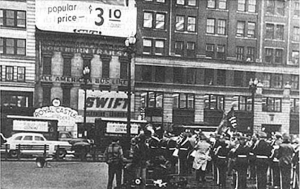
- Col. T. E. Lawrence. (Lawrence of Arabia) Revolt in the Desert. George H. Doran Company, 1926. ↵
